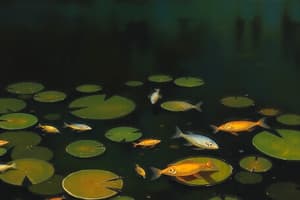Podcast
Questions and Answers
What is the phylum of Planaria?
What is the phylum of Planaria?
- Platyhelminthes (correct)
- Annelida
- Mollusca
- Arthropoda
What are Auricles?
What are Auricles?
Ear-like lobe with many sensory cells that functions for smell.
What is the pharynx?
What is the pharynx?
Throat that can be protruded through the ventral mouth opening when feeding.
What is the function of the pharyngeal sheath?
What is the function of the pharyngeal sheath?
What does the gastrovascular cavity refer to?
What does the gastrovascular cavity refer to?
What are cerebral ganglia?
What are cerebral ganglia?
What are nerve cords?
What are nerve cords?
What do transverse nerves connect to?
What do transverse nerves connect to?
What are lateral nerves?
What are lateral nerves?
What are Ocelli?
What are Ocelli?
What happens to the eggs in the ovaries?
What happens to the eggs in the ovaries?
What is the function of the oviduct?
What is the function of the oviduct?
What do yolk glands produce?
What do yolk glands produce?
Where do the testes occur?
Where do the testes occur?
What is the function of the vas deferens?
What is the function of the vas deferens?
What are seminal vesicles?
What are seminal vesicles?
What does the seminal receptacle do?
What does the seminal receptacle do?
How do planarians rid themselves of undigested food?
How do planarians rid themselves of undigested food?
Are planarians monoecious or dioecious?
Are planarians monoecious or dioecious?
What might be the advantage of an intestine with three branches?
What might be the advantage of an intestine with three branches?
Why do flatworms have cilia on the ventral epidermis but not on the dorsal?
Why do flatworms have cilia on the ventral epidermis but not on the dorsal?
Flashcards are hidden until you start studying
Study Notes
Phylum Platyhelminthes, Class Turbellaria, Genus Planaria
- Phylum Platyhelminthes includes flatworms with soft-bodied characteristics.
- Class Turbellaria encompasses mostly free-living species, primarily found in aquatic environments.
- The genus Planaria is notable for its regenerative abilities and is often studied in biological research.
Key Anatomical Features
-
Auricles:
- Ear-like lobes rich in sensory cells, primarily for smell, not hearing.
-
Pharynx:
- Functions as a throat, can extend through the ventral mouth for feeding.
-
Pharyngeal Sheath:
- Protective structure surrounding the pharynx, providing physical support.
-
Gastrovascular Cavity:
- Serves as the primary digestive tract for nutrient processing.
-
Cerebral Ganglia:
- Clusters of nerve cells located at the anterior end, acting as a rudimentary brain.
-
Nerve Cords:
- Double row of longitudinally connected ganglia, forming the central nervous system.
-
Transverse Nerves:
- Connective structures creating a ladder-like organization within the nervous system.
-
Lateral Nerves:
- Extend outward from nerve cords, contributing to the nervous system's complexity.
-
Ocelli:
- Simple eye spots that detect light and movement, aiding in navigation.
Reproductive Anatomy
-
Ovaries:
- Fertilization occurs as eggs pass down the oviduct to be discharged.
-
Oviduct:
- Transports sperm anteriorly and facilitates posterior fertilization of eggs.
-
Yolk Glands:
- Produce yolk, which nourishes developing eggs.
-
Testis:
- Located throughout the body, responsible for sperm production.
-
Vas Deferens:
- Carries sperm from testes to vesicles for subsequent storage.
-
Seminal Vesicle:
- Simple tubular glands found posterior to the urinary bladder in various male mammals.
-
Seminal Receptacle:
- Structure that receives sperm from a mating partner during reproduction.
Digestive and Excretory Processes
- Undigested Food Elimination:
- Planarians regurgitate any indigestible remnants from their digestive cavity.
Sexuality and Reproduction
- Monoecious Nature:
- Planarians possess both male and female reproductive organs, allowing them to engage in self-fertilization or cross-fertilization.
Adaptations and Functionality
-
Three-branched Intestine:
- Enhances nutrient diffusion efficiency; minimizes distance between food source and cells.
-
Cilia on Ventral Epidermis:
- Facilitate movement and locomotion while absent on the dorsal side for streamlined body structure.
Studying That Suits You
Use AI to generate personalized quizzes and flashcards to suit your learning preferences.




